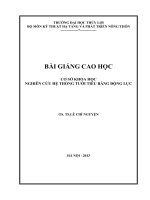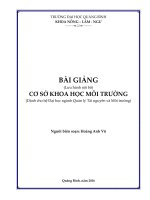Bài giảng Cơ sở khoa học của biến đổi khí hậu (Đại cương về BĐKH) – Phần II: Bài 8 – ĐH KHTN Hà Nội
Bạn đang xem bản rút gọn của tài liệu. Xem và tải ngay bản đầy đủ của tài liệu tại đây (45.63 MB, 40 trang )
VNU HANOI UNIVERSITY OF SCIENCE
REGIONAL CLIMATE MODELING AND CLIMATE CHANGE
CƠ SỞ KHOA HỌC
CỦA BIẾN ĐỔI KHÍ HẬU
(Đại cương về BĐKH)
Phần II
----------------------------------------------------------Phan Van Tan
B08: Biến đổi trong các thành phần hệ thống khí hậu
Bài 1: Các thành phần của hệ thống khí hậu
Bài 2: Sự truyền bức xạ và khí hậu
Bài 3: Hồn lưu khí quyển và khí hậu
Bài 4: Bề mặt đất, Đại dương và khí hậu
Bài 5: Lịch sử và sự tiến triển của khí hậu Trái đất
Bài 6: Khái niệm về Biến đổi khí hậu
Bài 7: Tác động bức xạ và BĐKH
Bài 8: Biến đổi trong các thành phần của hệ thống khí hậu
Bài 9: Biến đổi của các hiện tượng cực đoan
Bài 10: Giới thiệu về khí hậu Việt Nam
Bài 11: Biến đổi khí hậu ở Việt Nam
Bài 12: Mơ hình hóa khí hậu
Bài 13: Dự tính khí hậu
Bài 14: Xây dựng kịch bản BĐKH
Bài 15: Tác động của BĐKH và tính dễ bị tổn thương do BĐKH
Biến đổi các thành phần khí quyển
Tăng nhanh từ những năm 1950
Biến đổi các thành phần khí quyển
| CO2: was 390.5 ppm (390.3÷390.7) in 2011; è 40%
greater than in 1750 (276.4 ppm)
| N2O: was 324.2 ppb (324.0÷324.4) in 2011; è 20%
greater than in 1750 (270.00 ppb)
| CH4 was 1803.2 ppb (1801.2÷1805.2) in 2011; è 150%
greater than before 1750 (719.01 ppb).
| Hydrofluorocarbons (HFCs), perfluorocarbons (PFCs),
and sulphur hexafluoride (SF6) all continue to increase
relatively rapidly, but their contributions to radiative
forcing are less than 1% of the total by well-mixed
GHGs.
Biến đổi các thành phần khí quyển
Biến đổi các thành phần khí quyển
( climate-changeatmospheric-carbon-dioxide)
Biến đổi các thành phần khí quyển
Timeseries (a) and the Rate Of
Change (ROC=d/dt) (b) in
GHG concentrations in recent
decades
• Linear trends
• Variation of ROC
Biến đổi các thành phần khí quyển
(a) Annual average aerosol optical
depth (AOD) trends at 0.55 µm for
2000–2009, based on
deseasonalized, conservatively
cloud-screened MODIS aerosol
data over oceans. Negative AOD
trends off Mexico are due to
enhanced volcanic activity at the
beginning of the record. Most nonzero trends are significant (i.e., a
trend of zero lies outside the 95%
confidence interval).
(b) Seasonal average AOD trends at
0.55 µm for 1998–2010 using
SeaWiFS data. White areas
indicate incomplete or missing
data. Black dots indicate
significant trends (i.e., a trend of
zero lies outside the 95%
confidence interval) (IPCC, 2013)
Biến đổi trong các nguồn năng lượng bức xạ
Global mean energy budget under present-day climate conditions. Numbers state magnitudes
of the individual energy fluxes in W/m2, adjusted within their uncertainty ranges to close the
energy budgets. Numbers in parentheses attached to the energy fluxes cover the range of
values in line with observational constraints. (IPCC, 2013)
Biến đổi của nhiệt độ bề mặt
| Một số nhận định từ AR4:
{
{
{
{
{
{
{
{
{
Số liệu quan trắc 157 năm qua (đến 2005) cho thấy nhiệt độ bề mặt tăng lên với
những biến động theo vùng rõ rệt
Trong 100 năm, từ 1906 đến 2005 nhiệt độ đã tăng +0,74±0,18ºC, nhanh hơn bất
kỳ thế kỷ nào trong lịch sử, kể từ thế kỷ 11 đến nay
Tốc độ tăng nhiệt độ trong 50 năm cuối là +0,13±0,03ºC/thập kỷ, gần bằng hai
lần tốc độ tăng trong thời kỳ 1906-2005
Tốc độ nóng lên trên đất liền lớn hơn trên đại dương. Trong giai đoạn
1979-2005, nhiệt độ trên đất liền tăng 0,27ºC/thập kỷ còn trên đại dương là
0,13ºC/thập kỷ
Những nơi nóng lên mạnh nhất nằm ở sâu trong lục địa châu Á và Tây Bắc của
Bắc Mỹ
Trung bình tồn cầu, sự nóng lên trong thế kỷ 20 đã xảy ra ở hai pha, từ khoảng
những năm 1910 đến những năm 1940 (0.35°C), và mạnh hơn là từ những năm
1970 đến nay (0.55°C)
25 năm gần đây tốc độ nóng lên được gia tăng
Trong 12 năm, từ 1995-2006, có 11 năm, trừ 1996, là những năm nóng nhất kể
từ 1850.
Từ cuối những năm 1950 tầng đối lưu (cho đến khoảng 10km) có tốc độ nóng lên
lớn hơn một ít so với bề mặt, còn ở tầng KQ khoảng 10-30km đã bị lạnh đi đáng
kể từ 1979.
Biến đổi của nhiệt độ bề mặt
It is certain that globally averaged
LSAT has risen since the late 19th
century and that this warming has been
particularly marked since the 1970s
Global annual average land-surface air temperature (LSAT) anomalies relative to a 1961–
1990 climatology from the latest versions of four different data sets (Berkeley, CRUTEM,
GHCN and GISS) (IPCC, 2013)
entirely
new
structurally
distinct
product
etis al.,
2013b)
and to
under-estimate adjustm
and
to(Simmons
under-estimate
adjustments.
This
propensity
critically
dependent
analyses
et al.,
2010).
Various
invesreplicated
in and
the ERA
reanalyses
(Simmons
et(Rohde
al.,2012a).
2010).
Various
inves2012a).
aofSimmons
complete
reprocessing
ofnature
GHCN
al., 2011).
of
upon the (unknown) natu
ne
upon
the
(unknown)
of(Lawrimore
theal.,inhomogeneities
in None
the
007;
et
al.,
2010;
Parker,
2011;
Vose
et2010;etParker,
tigators
(Onogi
et
al., 2007;
Simmons
et
2011;
Voseraw
et data
these
yielded
more
minor
perturbations
the
global
LSAT
records
Their
homogeniza
ords
records.
Their
homogenization
increases
both
minimum
temperature
LSAT
estimates
fromthan
modern
were
Regional
analyses
of LSATrecords.
have not
been
limited
to
al.,
2012a)
showed
that
LSATreanalyses
estimates
fromtomodern
reanalyses
were
Regional
analyses
of LSAT
since
1900.
Willett
ettemperature
al. (2008)
and
Peterson
et
al. (2011)
and
maximum
temperatu
icitly
and
maximum
centennial-time-scale
USA explicitly
average
LSAT
in
quantitative
agreement
with observed
products.
Various
national
and
regio
ent
with
observed
products.
Various
national
and regional
studies
have
undertak
showed
that Since
changes
specific
and relative
humidity
trends.
19792009;
theseBo
ad
.5.5)
trends.
1979inthese
adjusted
data agree
with a(Section
range of2.5.5)
reanalysis
Europe
(Winkler,
Europe
(Winkler,
2009;
Bohm
et Since
al.,
2010;
Tietavain
were products
physically
consistent
reported
temperature
a result
products
esult
thewith
raw
not (Fall et trends,
al.,intervals
2010;
Vosefor
et al.,
Trend whereas
estimates
andrecords
90%doconfidence
LSAT whereas
global the raw
replicated
in the ERA reanalyses (Simmons et al., 2010). Various inves- 2012a).
nves2012a).
average
values
over
five
common
(IPCC,
2013)
Table
2.4:
| Trend
estimates(Box
and2.2)
90%forconfidence
intervals
(Box
2.2) over
forperiods
LSAT
global
average
values
over five common perio
and
90%
confidence
intervals
LSAT
global
average
values
five
common
periods.
(Onogi et al., 2007; Simmons et al., 2010; Parker, 2011; Vose et
se tigators
et
al., 2012a)
showed
that of
LSAT
estimates
reanalyses
wereStates.
Regional analyses of LSAT
were
Regional
analyses
LSAT
have notfrom
beenmodern
limited
to the United
Trends in °C per decadeTrends in °C per decade
Data
Set and regional
in quantitative
agreement
with observed
Various national and regio
Various
national
studiesproducts.
have undertaken assessments for
1880–2012
1901–2012
1901–1950
1880–2012
1901–2012
1901–1950
1951–2012
Europe (Winkler, 2009; Bo
Europe (Winkler, 2009; Bohm et al., 2010; Tietavainen et al., 2010; van
Biến đổi của nhiệt độ bề mặt
(Jones
et al., 2012)
012)CRUTEM4.1.1.0
0.086
± 0.015
0.086
± 0.015
0.095
± 0.020
0.095
± 0.020
0.097
± 0.029
0.097
± 0.029
0.175
± 0.037
GHCNv3.2.0 0.094
(Lawrimore
et al., 2011)
2011)
± 0.016
0.094
± 0.016
0.107
± 0.020
0.107
± 0.020
0.100
± 0.033
0.100
± 0.033
0.197
± 0.031
0.099 ± 0.020
0.098 ± 0.032
0.188 ± 0.032
2.4:
| Trend
estimates
and 90%
confidence
intervals (Box 2.2) for LSAT
global average values over
five common perio
balTable
average
values
over
five common
periods.
GISS (Hansen et al., 2010)
0.095 ± 0.015
0.099 ± 0.020
0.098 ± 0.032
0.095 ± 0.015
Berkeley
(Rohde
et
2013)
0.094
0.013
Trends
in±al.,°C
per
0.094
± 0.013
± 0.017
decade 0.101
0.101
± 0.017
0.111
± 0.034
1880–2012
1951–2012
1901–2012
1979–2012
1901–1950
et 0.029
al., 2012)
0.020CRUTEM4.1.1.0 (Jones
0.097 ±
0.086
0.175 ± 0.015
0.037
0.095
0.254 ± 0.020
0.050
0.097 ± 0.029
al., 2011)
0.020GHCNv3.2.0 (Lawrimore
0.100 ± et
0.033
0.094
0.197 ± 0.016
0.031
0.107
0.273 ± 0.020
0.047
0.100 ± 0.033
2010)
0.020GISS (Hansen et al.,
0.098
± 0.032
0.095
0.188 ± 0.015
0.032
0.099
0.267 ± 0.020
0.054
0.098 ± 0.032
al., 2013)
0.017Berkeley (Rohde et
0.111
± 0.034
0.094
0.175 ± 0.013
0.029
0.101
0.254 ± 0.017
0.049
0.111 ± 0.034
2012
Data Set
1901–1950
0.111
± per
0.034decade
0.175
0.029
Trends
in±°C
187
Biến đổi của nhiệt độ bề mặt
(c)
(a)
(b)
Global annual average SST and Night Marine
Air Temperature (NMAT) relative to a 1961–
1990 from:
(a) gridded SST observations, the raw SST
measurement archive and night marine air
temperatures,
(b) state of the art data sets.
(c) Global monthly mean SST anomalies
relative to a 1961–1990 from satellites
(ATSRs) and in situ records (HadSST3)
(IPCC, 2013)
Biến đổi của nhiệt độ bề mặt
Decadal global mean surface temperature (GMST)
anomalies relative to a 1961–1990 (white vertical lines
in grey blocks) and their uncertainties (90% confidence
intervals as grey blocks) based upon the LSAT and SST
combined HadCRUT4 ensemble (IPCC, 2013)
Annual global mean surface temperature (GMST) anomalies relative to a
1961–1990 from the latest version of the three combined LSAT and SST
data sets (HadCRUT4, GISS and NCDC MLOST) (IPCC, 2013)
Xu thế biến đổi của nhiệt độ bề mặt
From HadCRUT4,
GISS and NCDC
MLOST data sets for
1901–2012 period.
From NCDC MLOST
for three periods of
1911–1940, 1951–
1980, and 1981–2012
White areas indicate
incomplete or missing
data. Black plus signs
(+) indicate grid boxes
where trends are
significant (IPCC,
2013), (IPCC, 2013)
-0.6
Figure 2.21 | Trends in surface temperature from the three data sets of Figure 2.20
for 1901–2012. White areas indicate incomplete or missing data. Trends have been
calculated only for those grid boxes with greater than 70% complete records and more
than 20% data availability in first and last decile of the period. Black plus signs (+)
indicate grid boxes where trends are significant (i.e., a trend of zero lies outside the 90%
confidence interval). Differences in coverage primarily reflect the degree of interpolation
to account for data void regions undertaken by the data set providers ranging from none
beyond grid box averaging (HadCRUT4) to substantial (GISS).
Xu thế biến đổi của nhiệt độ bề mặt
1850
1900
1950
2000
Figure 2.20 | Annual global mean surface temperature (GMST) anomalies relative to a
1961–1990 climatology from the latest version of the three combined land-surface air
temperature (LSAT) and sea surface temperature (SST) data sets (HadCRUT4, GISS and
NCDC MLOST). Published data set uncertainties are not included for reasons discussed
in Box 2.1.
Trend estimates and 90% confidence intervals for global mean surface temperature (GMST)
over
common
(IPCC, 2013)
Table 2.7 | Same as Table 2.4, but for global mean
surfacefive
temperature
(GMST) overperiods.
five common periods.
Data Set
Trends in °C per decade
1880–2012
1901–2012
1901–1950
1951–2012
1979–2012
HadCRUT4 (Morice et al., 2012)
0.062 ± 0.012
0.075 ± 0.013
0.107 ± 0.026
0.106 ± 0.027
0.155 ± 0.033
NCDC MLOST (Vose et al., 2012b)
0.064 ± 0.015
0.081 ± 0.013
0.097 ± 0.040
0.118 ± 0.021
0.151 ± 0.037
GISS (Hansen et al., 2010)
0.065 ± 0.015
0.083 ± 0.013
0.090 ± 0.034
0.124 ± 0.020
0.161 ± 0.033
193
| Trends are different among data sets
| HadCRUT4:
{ the warming from 1850–1900 to 1986–2005 is 0.61 [0.55 to
0.67] °C (90% confidence interval),
{ the warming from 1850–1900 to 2003–2012 (the most recent
decade) is 0.78 [0.72 to 0.85] °C
Biến đổi trong chu trình nước
Observations: Atmosphere and Surface
Chapter 2
Trend estimates and 90% confidence intervals for annual
precipitation for each time series over two periods
Table 2.10 | Trend estimates and 90% confidence intervals (Box 2.2) for annual precipitation for each time series in Figure 2.28 over two periods. Dashes indicate not enough
data available for trend calculation. For the latitudinal band 90°S to 60°S not enough data exist for each product in either period.
Area
Data Set
CRU TS 3.10.01 (updated from Mitchell and
Jones, 2005)
GHCN V2 (updated through 2011; Vose et al., 1992)
GPCC V6 (Becker et al., 2013)
Smith et al. (2012)
Trends in mm yr–1 per decade
1901–2008
1951–2008
60°N–90°N
–
5.82 ± 2.72
30°N–60°N
3.82 ± 1.14
1.13 ± 2.01
30°S–30°N
0.89 ± 2.89
–4.22 ± 8.27
60°S–30°S
3.88 ± 2.28
–3.73 ± 5.94
60°N–90°N
–
4.52 ± 2.64
30°N–60°N
3.23 ± 1.10
1.39 ± 1.98
30°S–30°N
1.01 ± 3.00
–5.15 ± 7.28
60°S–30°S
–0.57 ± 2.27
–8.01 ± 5.63
60°N–90°N
–
2.69 ± 2.54
30°N–60°N
3.14 ± 1.05
1.50 ± 1.93
30°S–30°N
–0.48 ± 3.35
–4.16 ± 9.65
60°S–30°S
2.40 ± 2.01
–0.51 ± 5.45
60°N–90°N
–
0.63 ± 1.27
30°N–60°N
1.44 ± 0.50
0.97 ± 0.88
30°S–30°N
0.43 ± 1.48
0.67 ± 4.75
60°S–30°S
2.94 ± 1.40
0.78 ± 3.31
• Precipitation over tropical land areas
(30°S to 30°N) has increased over the last
decade reversing the drying trend that
occurred from the mid-1970s to
mid-1990s.
Annual precipitation anomalies averaged
• As a result the period 1951–2008 shows
over land areas for four latitudinal bands
no significant overall trend in tropical land
and the globe from five global precipitation
data sets relative to a 1981–2000
precipitation in any of the datasets
CRU 1901-2010
CRU 1951-2010
GHCN 1901-2010
GHCN 1951-2010
GPCC 1901-2010
GPCC 1951-2010
Biến đổi trong chu trình nước
• Increases for the period
1901–2010 are seen in
the mid- and higherlatitudes of both the NH
and SH consistent with
the reported changes for
latitudinal bands.
• Most areas show similar
trends between the 1901–
2010 and 1951–2010
periods with few
exceptions Trends over
shorter periods can differ
from those implied for
the longest periods
Trends in annual precipitation over land from the CRU, GHCN and GPCC data sets for 1901–
2010 (left) and 1951–2010 (right). White areas indicate incomplete or missing data. Black plus
signs (+) indicate grid boxes where trends are 90% significant
Biến đổi trong chu trình nước
| Changes in Snowfall:
{ It is likely that decreasing numbers of snowfall events are occurring where
increased winter temperatures have been observed (North America, Europe,
Southern and East Asia)
{ Confidence is low for the changes in snowfall over Antarctica
| Streamflow and Runoff:
{ Confidence is low for an increasing trend in global river discharge during the 20th
century
| Evapotranspiration Including Pan Evaporation:
{ Pan evaporation continued to decline in most regions studied since AR4 related to
changes in wind speed, solar radiation and humidity
{ On a global scale, evapotranspiration over land increased from the early 1980s up
to the late 1990s.
{ After 1998, a lack of moisture availability in SH land areas, particularly decreasing
soil moisture, has acted as a constraint to further increase of global
evapotranspiration
| Surface Humidity:
{ Global near surface air specific humidity has increased since the 1970s
{ During recent years the near surface moistening over land has abated. As a result,
fairly widespread decreases in relative humidity near the surface are observed over
the land in recent years
Biến đổi trong hồn lưu khí quyển
Trends in sea level
pressure (SLP), 500 hPa
geopotential height (GPH)
and 100 hPa GPH in
November to April
1979/1980 to 2011/2012
and May to October 1979
to 2011 from ERA-Interim
data. Trends are shown
only if significant
• The spatial distribution of SLP represents the distribution of atmospheric mass,
which is the surface imprint of the atmospheric circulation
• Sea level pressure has likely decreased from 1979 to 2012 over the tropical
Atlantic and increased over large regions of the Pacific and South Atlantic, but
trends are sensitive to the time period analysed owing to large decadal variability
Biến đổi trong hồn lưu khí quyển
Sea Level Pressure (SLP)
Decadal averages of SLP from the 20th Century Reanalysis (20CR) for November of previous year to
April and May to October shown by two selected contours: 1004 hPa (dashed lines) and 1020.5 hPa (solid
lines). Topography above 2 km above mean sea level in 20CR is shaded in dark grey.
•
•
The spatial distribution of SLP represents the distribution of atmospheric mass, which is
the surface imprint of the atmospheric circulation
Sea level pressure has likely decreased from 1979 to 2012 over the tropical Atlantic and
increased over large regions of the Pacific and South Atlantic, but trends are sensitive to
the time period analysed owing to large decadal variability
Biến đổi trong hồn lưu khí quyển
Tropical Circulation
(a) Indices of the strength of the
northern Hadley circulation in
December to March (Ψmax is the
maximum of the meridional mass
stream function at 500 hPa between
the equator and 40°N)
(b) Indices of the strength of the
Pacific Walker circulation in
September to January (Δω is the
difference in the vertical velocity
between [10°S to 10°N, 180°W to
100°W] and [10°S to 10°N, 100°E to
150°E], Δc is the difference in cloud
cover between [6°N to 12°S, 165°E to
149°W] and [18°N to 6°N, 165°E to
149°W], VE is the effective wind
index, u is the zonal wind at 10 m
averaged in the region [10°S to 10°N,
160°E to 160°W], ΔSLP is the SLP
difference between [5°S to 5°N,
160°W to 80°W] and [5°S to 5°N,
80°E to 160°E]
Biến đổi trong hồn lưu khí quyển
Tropical Circulation
Annual average tropical belt width and tropical edge latitudes in each hemisphere.
The tropopause (red), Hadley cell (blue), and jet stream (green) metrics are based
on reanalyses; outgoing longwave radiation (orange) and ozone (black) metrics are
based on satellite measurements. The ozone metric refers to equivalent latitude
Biến đổi trong hồn lưu khí quyển
| Tropical Circulation
{
{
{
{
{
{
{
{
Evidence for trends and variability in the strength of the Hadley and Walker
circulations, the monsoons, and the width of the tropical belt is observed based on
reanalysis data
Changes in the tropical circulation imprint on other fields that are observed from
space
Changes in the average state of the tropical circulation are constrained to some
extent by changes in the water cycle
Changes in the monsoon systems are expressed through altered circulation,
moisture transport and convergence, and precipitation
A weakening of the East Asian summer monsoon since the 1920s is also found in
SLP gradients
The strength of the northern Hadley circulation in boreal winter and of the Pacific
Walker circulation in boreal fall and winter is largely related to the ENSO
Observed changes in several atmospheric parameters suggest that the width of the
tropical belt has increased at least since 1979
In summary, large interannual-to-decadal variability is found in the strength of the
Hadley and Walker circulation
Biến đổi trong nhiệt độ đại dương
(a) Depth-averaged 0 to 700 m temperature trend for 1971–
2010 (longitude vs. latitude, colours and grey contours
in oC/decade)
(b) Zonally averaged temperature trends (latitude vs. depth,
colours and grey contours in degrees Celsius per
decade) for 1971–2010 with zonally averaged mean
temperature over-plotted (black contours in oC/decade)
(c) Globally averaged temperature anomaly (time vs. depth,
colours and grey contours in degrees Celsius) relative to
the 1971–2010 mean
(d) Globally averaged temperature difference between the
ocean surface and 200 m depth (black: annual values,
red: 5-year running mean)
• The upper ocean (0-700 m) warmed from 1971-2010
• The warming rate is 0.11 [0.09-0.13]°C per decade in
the upper 75 m, decreasing to about 0.015°C per decade
by 700 m
• The upper ocean warmed over the first half of the 20th
century; the waters from 700 to 2000 m have warmed
on average between 1957 and 2009
• The deep (2000 m to bottom) North Atlantic Ocean north of 20°N warmed from 1955-1975, and
then cooled from 1975-2005, with an overall cooling trend.









